
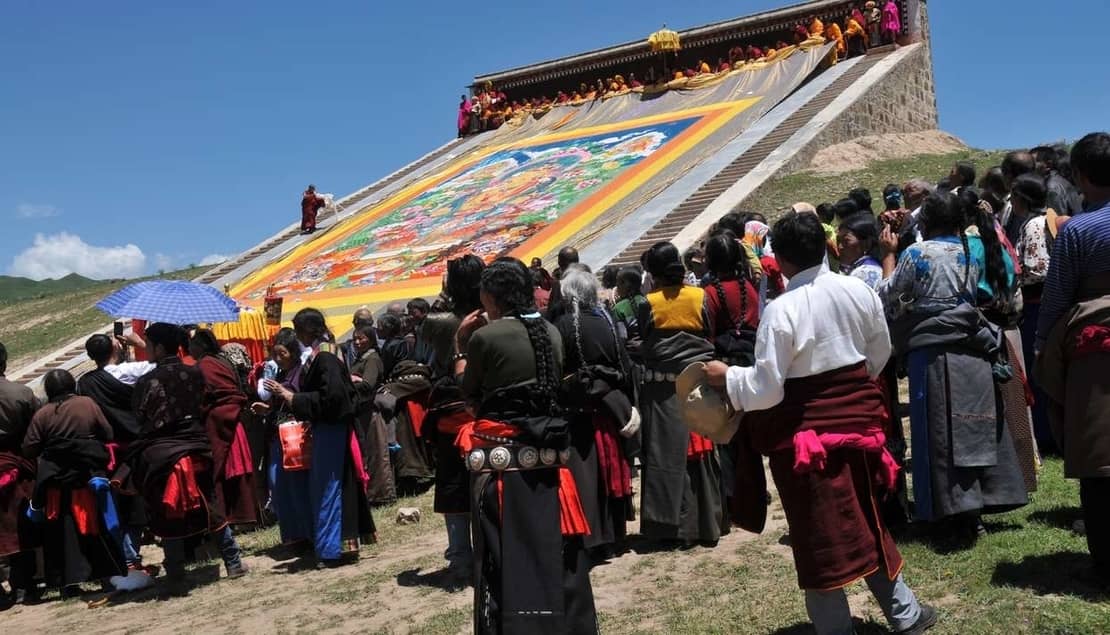
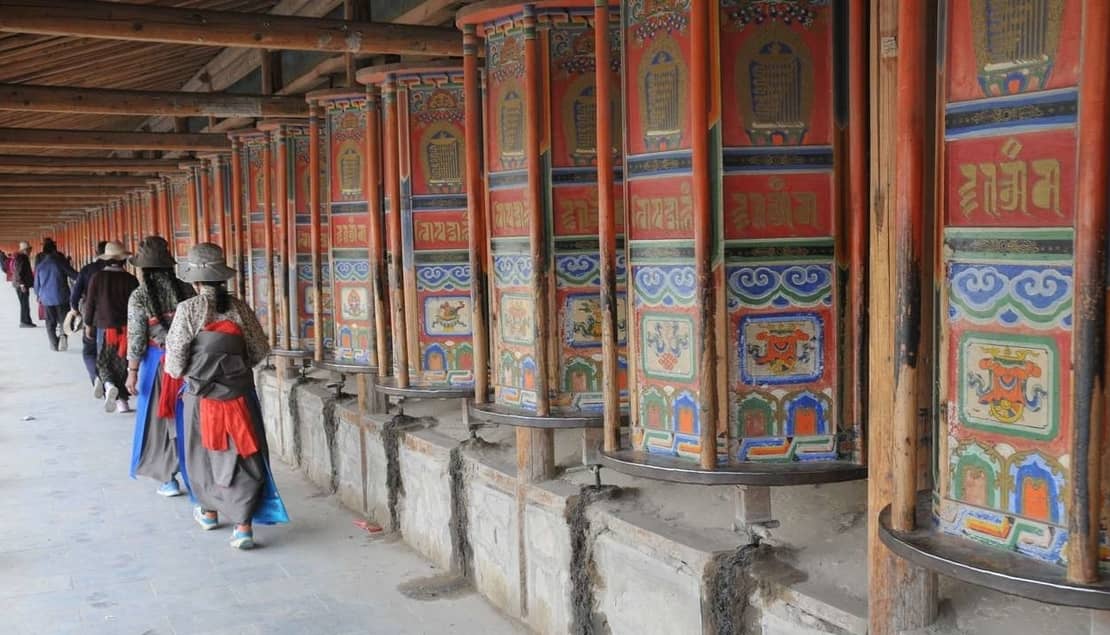
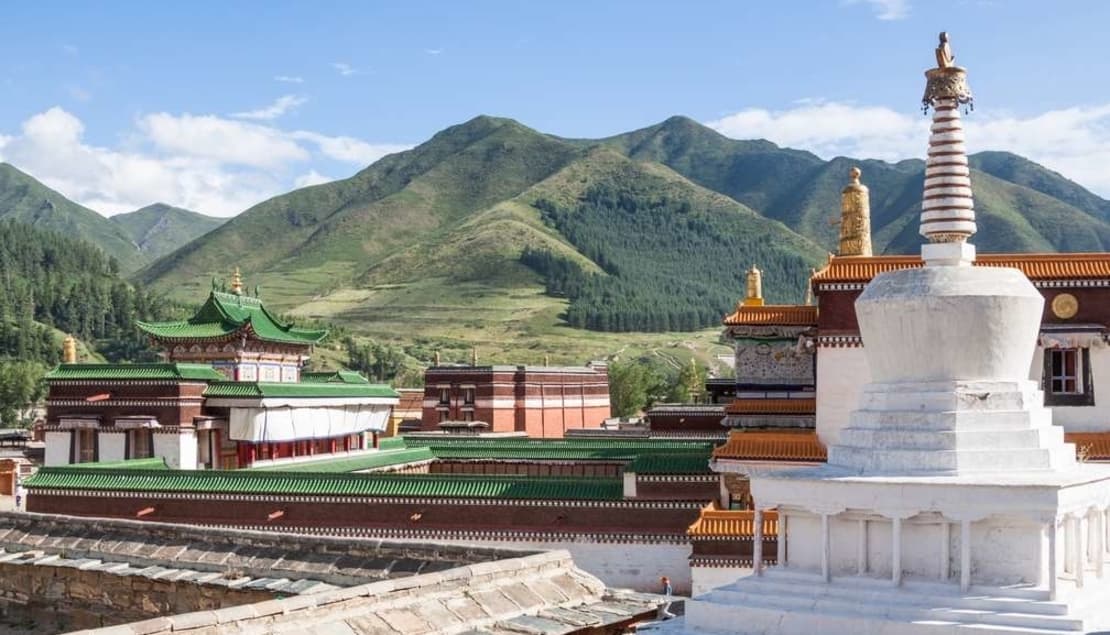
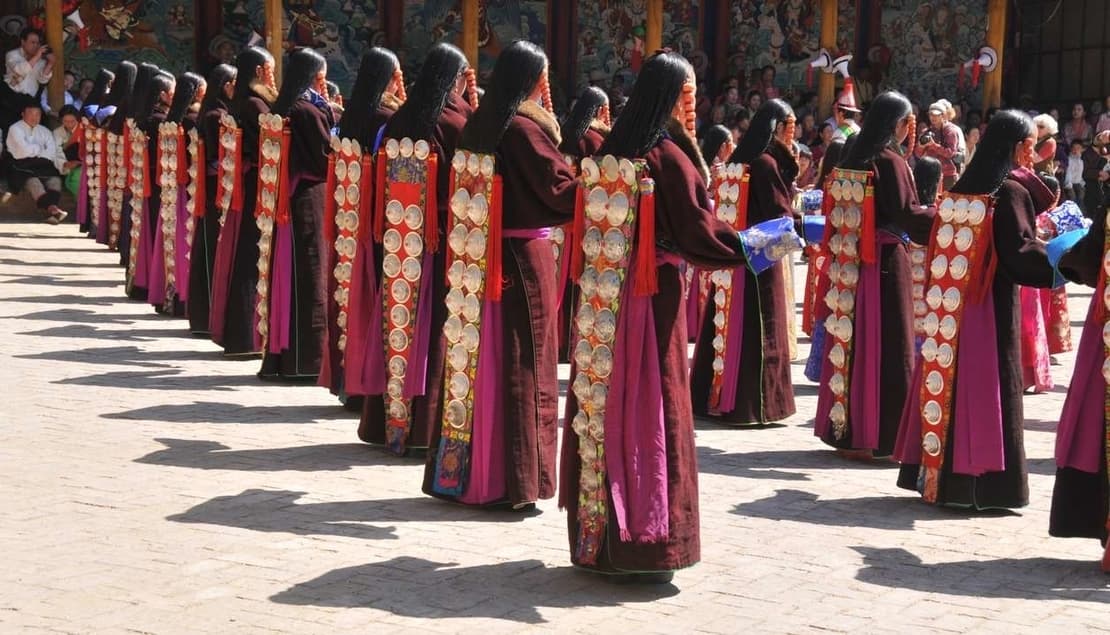

This trip is all about the Tibetan culture, visiting an area in northwest China on the Tibetan plateau. Most of what will be seen during this tour is more Tibetan than Chinese. During the trip gain a fascinating insight into the culture and traditions of China's minority tribes including the Hui, Tu, Mongolians and Tibetans, travelling in a part of the country far removed from the trappings of modern China.
- Meet Tibetans, visit their homes, to understand and appreciate Tibetan culture
- Experience two traditional Tibetan Festivals
- Travel with Gina Corrigan an expert in textiles of this region
- Spend a day with a nomadic family, gaining an insight into their lifestyle
Travel to many Tibetan villages, meet the villagers and visit monasteries including Tibet's most revered Labrang monastery with its famous Buddhist philosophy school. It is home to the largest number of monks outside the Tibetan Autonomous Region. Experience the hospitality of a nomadic family, spending a day discussing their lifestyle and examining a ger (a traditional portable round tent).
One of the highlights of this trip is experiencing two traditional Tibetan festivals. The first being the Molam Prayer Festival, one of the most important Tibetan Buddhist celebrations of the year. The second on the trip is the Tongren Shaman Festival, a grand occasion for local Tibetan and Tu people to show their devotion to the Mountain God. These are both special festivals to experience where few tourists visit and a chance to see locals in their finest traditional clothing.
This tour is led by Gina Corrigan, an expert on textiles and embroidery, much of the emphasis on this trip will be on textiles, learning about traditional weaving techniques and discovering the meaning of the varied and historic costumes still worn by the local people in Qinghai.
Itinerary at a glance
Day 1: Beijing
The starting point for the group is the Jianguo Garden Hotel in Beijing. Please speak to one of our team should you need help organising an arrival transfer.
You will meet with the rest of the group for a short briefing at the arrival hotel - meeting time to be confirmed in your final documentation.
Beijing is China's capital, and a city of epic proportions. It is a cauldron of history, culture and enterprise. Offering a feast of elaborate and ambitious architecture, world famous landmarks, and culinary delights.
A Day at Leisure
Spend the day relaxing after your flight. The hotel is within walking distance of Tianamen Square and the modern shopping street of Wangfujing. Alternatively, rest at the hotel before having an early dinner, the tour leader, Gina Corrigan will be on hand to offer suggestions.
Day 2: Beijing - Lanzhou
Fly Beijing to Lanzhou
Lanzhou
Arrive into Lanzhou, the capital of Gansu Province, to be met by the Tibetan guide and driver. Head 45 miles into the city of Lanzhou, which is situated on the Yellow River. A visit is planed to the Gansu Provincial Museum, which has many ancient artefacts from the Silk Road. The Neolithic pots are of great interest, as is the famous Flying Horse of Gansu, excavated in 1969.
Day 3: Lanzhou - Jone
Drive from Lanzhou to Jone (Road Journey)
Jone County is an adiministrative district in the Gansu Province. The county covers both banks of the middle section of the Lu-chu. The country town and adjacent Jone Monastery are on the north bank, while the valleys on the southern side used to be branches of the ancient kingdom of Jone. Jone County borders the Tibetan area and is inhabited by Tibetans.
Lanzhou to Jone
This morning driven to Jone, driving through moss covered hills where wheat, lily bulbs and fruit are grown. Jone County borders the Tibetan area and many Tibetans live in the region with the older women still dressing in a traditional style. The American botanist Joseph Rock spent almost two years in Jone between 1925-26, residing in the compound of the local chief, Tusi Yang Jiqing, making it his base for his exploration of southern Gansu and eastern Qinghai. His account of this almost unknown Tibetan area, and colour photographs, were later published in the National Geographic Magazine. Finish the day with a visit to the Jone Tibetan monastery.
Day 4: Jone - Hezuo
Drive from Jone to Hezuo (Road Journey)
Located at the junction area of Gansu, Qinghai and Sichuan provinces, is it the business centre for Tibetan and Chinese exchanges. Situated at the northeast edge of the Qinghai-Tibet Plateau, Hezuo is 170 miles north of Lanzhou.
Jone to Hezuo
The drive is 100 miles to Amchok monastery to attend the Molam festival also known as Sunning the Buddha. Around noon a huge silk thangka will be carried by the monks from the monastery and rolled down the hillside, which is crowded with Tibetan onlookers. A picnic lunch will be organised on the rolling grassland. Returning to Hezuo visit the modern town with its the excellent antique shops. There will be a discussion on Tibetan costume.
Day 5: Hezuo
Hezuo
The following day return to the Amchok Monastery for the colourful monastic masked dances. A picnic lunch will be arranged and the guide will ask a local family to show off thier jewellery and a typical chuba of the area. Visit a Tibetan home to chat about their lifestyle, costume and farming techniques.
Day 6: Hezuo - Xiahe
Drive from Hezuo to Xiahe (Road Journey)
The town of Xiahe is set in a scenic mountain valley and is a major centre of Buddhism. The people of Xiahe are a mixture of Tibetans and Muslims. The Tibetans rely largely on farming and herding and are swelled in number by visiting pilgrims. They are semi-nomadic whilst the Muslim population are engaged in trading. The town is home to Labrang Monastery, one of the most important monasteries of the Tibetan Yellow Hat Sect monasteries in China. There are now 1000 lamas at the monastery from an original total of 4000.
Hezuo to Xiahe
Driven 63 miles to the town of Xiahe, famous for its Labrang Yellow Sect monastery, situated on the edge of town. It is one of the most important Tibetan culture centres in Eastern Tibet and one of the six biggest monasteries in the Tibetan world, housing over 1000 monks. Its Buddhist Philosophy School is famous throughout the Tibet.
Day 7: Xiahe
Xiahe
The plan is to tour Labrang monastery in the morning. A Tibetan guide will show you the impressive interior of the Assembly Hall and other temples with its grand sculptural images of Buddha and protective deities. This afternoon visit the cloak makers, walk part of the kora - offering magnificent overviews of the monastery. Later, there is time to explore the Tibetan shops providing for the needs of nomads and the monastic communities. There are religious thangkas, Buddha statues, prayer flags, hand-printed sutras, women's embroidered plait extensions and nomadic jewellery for sale. Bargaining is necessary. Many shopkeepers are Muslims, and are locally called Hui Hui.
Day 8: Xiahe
Xiahe
Drive to Ganja via the Narang La Pass home to wild flowers and great grassland views followed by a visit to the recently resorted Bon monastery, founded 600 years ago. The Bon indigenous animist and shamanistic belief system of Tibet, revolves around the worship of nature and predates Buddhism. The highlight of the day will be a visit to a local family where they will demonstrate weaving and show their nomadic costumes. The plan is for the group to eat a simple lunch with the family.
Day 9: Xiahe - Henan
Drive from Xiahe to Henan (Road Journey)
Henan has a diverse landscape with floodplains in the east and the Xionger and Funiu mountains in the west. The Yellow River passes through central Henan, entering from the northwest. Henan is home to approximatley 120,000 historical relics, including over 40,000 rare ones. The economic prosperity resulted from Henan's extensive fertile plains and its location at the heart of the country.
Xiahe to Henan
Today, drive across an extensive nomadic pastureland where yak and sheep graze. Some herdsmen still live in the black yak hair, hand woven tents, but increasingly white canvas tents are replacing them. This afternoon, there will be plenty of time to visit the hillside Laka monastery with the opportunity to go into town and see the silversmiths at work making nomadic jewellery.
Day 10: Henan
Henan
The nomads in Henan are Mongolians following the passing through of the Mongol army during the Yuan Dynasty and some groups settled. Originally, they lived in felt yurts also known as 'gers' but, today they live in one storey houses. The younger generation live in the yurts during the summer months when the animals are pastured on the summer grasses. The plan is to visit the yurts and meet a local Mongolian family to gain a greater understanding of the yurt interiors and the careful organisation of their possessions. In town, hopefully see a sheepskin chubas, which are some of the best quality in Qinghai. The nomad guide will explain how the skins are treated and sewn, strangely the Mongolians now speak Tibetan.
Day 11: Henan - Tongren (Repkong)
Drive from Henan to Tongren (Repkong) (Road Journey)
Located on the edge of the Tibetan plateau, it is a small monastic town in the Qinghai province. The city is home to Dongshan Temple and the Statue of Zhou Yiqun Martyr. The Mount Fanjingshan National Nature Reserve is perhaps the most famous scenic area in the region.
Henan to Tongren and onto Repkong
This is an easy 93 mile drive to Tongren, known in Tibetan as Repkong, an agricultural area, where you will stay for four nights. This is one of the most famous locations for the making of applique and painted thangkas and the local Tibetans and Tu will hopefully demonstrate these two arts, as well the making of clay religious sculptures. The valley, at this time of year, will be a sea of long-haired barley surrounded by sand brown eroded hills with single-storied flat-roofed villages nestling in the hillsides.
Day 12: Tongren (Repkong)
Repkong
Today, explore some of the villages in the Repkong vicinity. Also, possibly travel to a Bon monastery, before walking down through a local farming village. Come across the colourful laptses, unique phenomena in this area. Have time to explore and shop in the town, where you will find Tibetan regalia and artefacts.
Day 13 and 14: Tongren (Repkong)
Shaman's Festival
The next two days will be spent at the annual Shaman's Festival. The Tibetan villagers worship the Mountain Gods and no Buddhist priests are allowed to take part in the ceremony. The village men dressed in traditional pulu chubas, meet early in the morning to pray and then perform slow elegant dances in the centre of the village. Various sacrifices are made to the Mountain God by the Shaman. In the past, animals were sacrificed but today effigies are used instead. The shaman remains in a trance throughout the day and whirls and dances with the men picking on any villager who has misbehaved in the past year, he is a frightening figure. Later in the day, young girls in superb chubas and bedecked in traditional coral Jewellery, dance slowly and elegantly. There are often fascinating costumed comedy skits. All the villagers dress in their best clothes to watch the performances until the final sacrifice is made. The thangka of the Mountain God is finally returned for safe keeping to the temple. This is a perfect opportunity to view old and modern dress.
Day 15: Tongren (Repkong) - Xining
Drive from Tongren (Repkong) to Xining (Road Journey)
Xining is the capital of Qinghai Province and lies on the edge of the Tibetan Plateau at 2,200m.
Repkong to Xining
Drive to Xining, the modern capital of Qinghai province to visit the Tibetan Culture Museum. The museum has a wide range of Tibetan artefacts, traditional Tibetan illustrated medicine texts and textiles, considered one of the best museums of Tibetan Culture in China.
Day 16: Xining - Beijing
Fly Xining to Beijing
An Afternoon at Leisure
Spend the afternoon at leisure, either at the hotel or discover the local area.
Day 17: Beijing
Today the tour comes to an end. Speak to us to arrange a transfer to the airport, or stay on and enjoy your stay in China.
WHY SHOULD I JOIN THIS GROUP TOUR?
To travel with Gina Corrigan, a specialist in textiles and Tibetan culture, who has been visiting this area for over 40 years. Also, travel with a Tibetan guide which will give an incredible insight into the local culture and customs, you will get to integrate with local people and be welcomed into their homes.
WHAT IS THE ACCOMMODATION LIKE?
Simple local hotels with private bathrooms.
DO I NEED TO BE FIT TO JOIN THIS TOUR?
You don’t need to be physically fit as there will be no long trekking but the areas visited will be at altitude of up to about 4,000 metres.
WHAT ARE THE ROADS LIKE IN CHINA?
Generally good tarmac roads throughout.
DO I NEED TO BE A TEXTILE EXPERT?
No, while the emphasise will be on textiles it is also a trip exploring the Tibetan beliefs and traditions.
Start your journey
Group size: Min 6 / Max 15
Tour expert: Gina Corrigan
WHAT IS INCLUDED
- Accommodation (as indicated)
- Accompanied by a local English speaking guide throughout
- Accompanied by Gina Corrigan in China
- Entrance Fees
- Gratuities for the local guide, driver and porters
- Internal flights
- Meals (as indicated)
- Transportation (as indicated)
Enquire for more information and availability.
More like this
We’re here to listen and inspire
to help you have the holiday of your lifetime.
We can do it all – advise, plan and book and we look after you on the journey.
Meet our peopleContact Concierge Traveller - A Virtuoso Travel Agency
Toll free 1800 047 047
International +61 2 8270 4800
Concierge House
332 Kent Street
Sydney NSW 2000
Australia
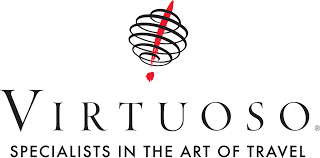
We are open 24hrs a day
-
London
-
Bangkok
-
Sydney
-
Honolulu
-
Rio de Janeiro

